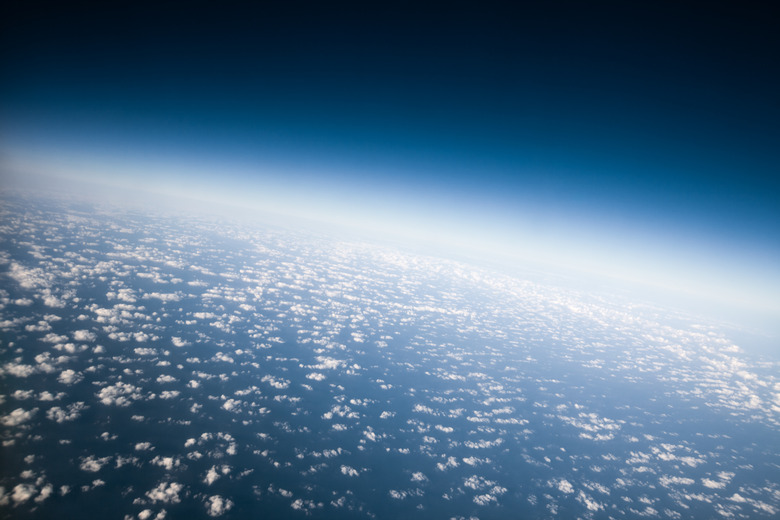What Is The Chemical Formula Of Ozone And How Is Ozone Formed In The Atmosphere?
Ozone is a simple chemical compound that contains only oxygen atoms, and its effects depend on where in the atmosphere it occurs. In the upper stratosphere, it forms a protective shield against solar ultraviolet radiation, but near the ground, it's a pollutant that can cause respiratory ailments in humans and animals. The creation and destruction of stratospheric ozone depend primarily on natural processes, but near the ground, industrial processes are mostly responsible for its creation.
TL;DR (Too Long; Didn't Read)
Ozone, with the chemical formula O3, forms from ordinary oxygen in the upper stratosphere with the energy from the sun's ultraviolet rays. Ozone also forms in the lower atmosphere from natural and industrial processes.
Chemical Composition
Chemical Composition
An ozone molecule consists of three oxygen atoms (O3), whereas the stable form of oxygen that normally exists in the atmosphere consists of only two. When certain chemical processes make an extra oxygen atom available, the highly reactive atom binds readily with an oxygen molecule. Ozone is also highly reactive, and its oxidizing ability is second only to fluorine. It is useful as a deodorizing and bleaching agent as well as for killing germs and purifying water. It is a pale blue gas at room temperature, and its strong odor is reminiscent of a thunderstorm because lightning strikes produce ozone.
Production of Stratospheric Ozone
Production of Stratospheric Ozone
Ultraviolet light from the sun reacts with oxygen molecules in the upper atmosphere to form the stratospheric ozone layer. When the energetic light strikes oxygen molecules, it breaks them into two separate oxygen atoms, and each of the highly reactive atoms bind with another oxygen molecule, resulting in the formation of two ozone molecules. These reactions occur most frequently over the tropics, where the sunlight is most intense. They are important because the ultraviolet radiation they absorb would otherwise reach the surface of the planet, where it would make it difficult for life to exist.
Production of Tropospheric Ozone
Production of Tropospheric Ozone
Because it is such a corrosive gas, ozone in the lower atmosphere is known as bad ozone, and a number of chemical reactions produce it. One of them occurs inside automobile engines, where oxygen and nitrogen gas combine to form nitric oxide. This gas reacts with oxygen to form nitrogen dioxide. On sunny, hot days, nitrogen dioxide breaks down again to release an oxygen atom, which in turn binds with an oxygen atom to form ozone. Emissions from factories and energy stations that burn fossil fuels also generate ozone through a similar process. Ozone also forms around high-voltage electrical equipment.
Ozone Pollution
Ozone Pollution
Ozone occurs naturally in the troposphere, mainly due to the release of hydrocarbons from plants and soil that break down in sunlight to nitric acid and oxygen radicals. Natural levels are seldom high enough to cause problems for humans, but the extra ozone from industrial processes and automobiles can cause a number of them. The highly reactive gas damages forests and crops, damages living tissue and causes respiratory ailments in sensitive individuals. Ozone levels in the troposphere aren't constant — they increase on hot sunny days in metropolitan and other areas of high industrial activity. Ozone is a primary component of smog.
Cite This Article
MLA
Deziel, Chris. "What Is The Chemical Formula Of Ozone And How Is Ozone Formed In The Atmosphere?" sciencing.com, https://www.sciencing.com/chemical-formula-ozone-ozone-formed-atmosphere-21514/. 7 May 2018.
APA
Deziel, Chris. (2018, May 7). What Is The Chemical Formula Of Ozone And How Is Ozone Formed In The Atmosphere?. sciencing.com. Retrieved from https://www.sciencing.com/chemical-formula-ozone-ozone-formed-atmosphere-21514/
Chicago
Deziel, Chris. What Is The Chemical Formula Of Ozone And How Is Ozone Formed In The Atmosphere? last modified August 30, 2022. https://www.sciencing.com/chemical-formula-ozone-ozone-formed-atmosphere-21514/
